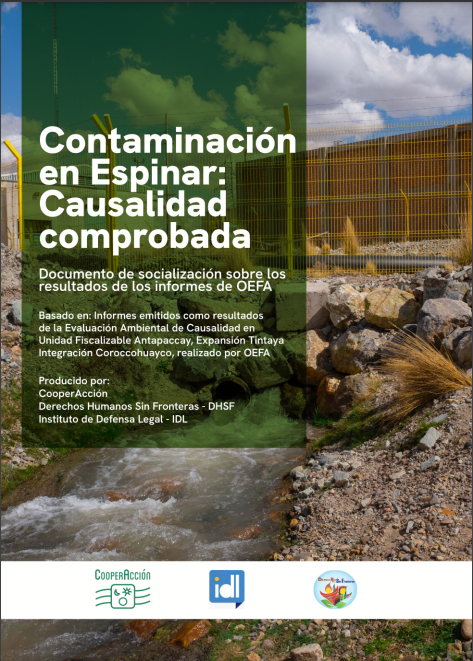Blog: Glencore mine in Espinar a proven source of contamination: Engaging with Affected Communities
Official studies show that pollution originating from the Antapaccay mine seriously affects groundwater, rivers, soil and air in the province of Espinar in Cusco. A new study summarizing the worst impacts was presented in Espinar, where members of various organizations and communities analyzed actions to address this crisis.
This blog is written by Thomas Niederberger of CooperAcción, a member of Finanzas con Derechos Peru - Fair Finance Peru

It’s the most extensive investigation about the causal link between the Glencore-owned copper mine and the contamination of the environment in Peru ever undertaken – but in Espinar, where the population has been denouncing the toxic impacts from Glencore’s Antapaccay mine for more than 10 years, few people know about it. A new publication, created by CooperAcción, Finanzas con Derechos Peru, Derechos Humanos Sin Fronteras and the Instituto de Defensa Legal does, therefore set out to change this, showing the most important findings in a simplified manner.
One of the main findings of the causality study conducted by the Peruvian government’s Environmental Assessment and Supervision Agency (Organismo de Evaluación y Fiscalización Ambiental, OEFA) in 2023 verifies the presence of toxic metals such as arsenic, lead and mercury in water bodies and pastures in several indigenous communities, including in Huisa, Huisa Ccollana, Huacané Bajo and Huancané Alto, Alto Huarca and others. The OEFA studies combine a variety of scientific methods to reach robust conclusions.
According to OEFA, the sources of contamination are to be found in the Tintaya tailings deposit, which leaks into the groundwater, as well as in several dumps and tailings deposits that are part of the extensive Tintaya-Antapaccay mining complex. In addition, there is air pollution from dust raised during blasting in the southern and northern pits of the mine, and a lowering of the groundwater table that has caused sinkholes and the disappearance of springs.
Informing and Involving Affected Communities
A considerable challenge is the fact that the OEFA’s findings are spread over six highly technical reports, divided along “environmental components” (water, air, soil, flora and fauna), over more than 1,500 pages. The reports are, furthermore, not freely available for download; CooperAccion obtained them through a public information request. There are, therefore, too many hurdles for the members of the affected indigenous communities to understand what is relevant for them and how to use this information to demand solutions.
The publication “Contaminación en Espinar: Causalidad comprobada” addresses this problem: the most severe impacts are described in accessible, simplified language and located on a map, next to quotes from the original OEFA reports, in an extra-large magazine format. It also contains a short assessment of legal actions that can be taken.
A draft version of the report received input from local experts and environmental defenders in Espinar in March. The printed version was then presented on 14 October at a workshop in Espinar, with representatives of different social organizations and communities of the province. Participants discussed possible actions in the face of the indifference of the authorities and the lack of response from the Glencore-Antapaccay mining company. They urged immediate action to contain the damage caused, the provision of safe water, the restoration of contaminated areas, and the closure of sources of toxic emissions. Legal responsibilities and possible actions to bring justice were also analysed.

The publication was prepared by CooperAcción, member of Finanzas con Derechos Peru - Fair Finance Peru - together with Derechos Humanos Sin Fronteras (Cusco, Peru) and the Instituto de Defensa Legal. It follows the Fair Finance International report and European speakers tour of 2023, supported by Oxfam.
For an analysis of the case in relation to the lack of compliance with international standards, see the report “Glencore in Peru: the case of Antapaccay”.
Download the publication here: “Contaminación en Espinar: Causalidad comprobada”
